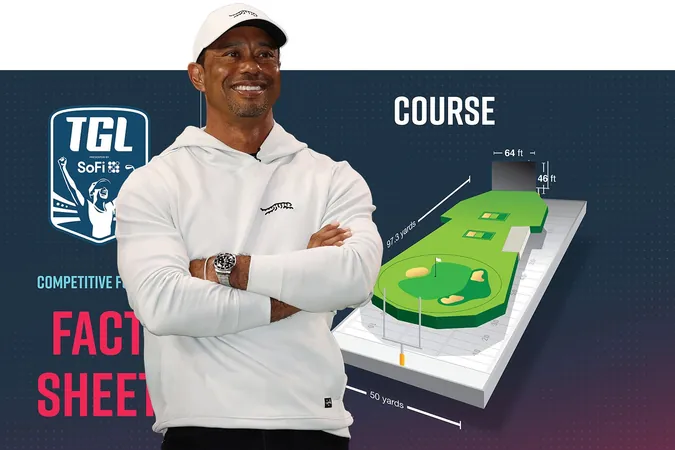
TGL Review: Is Tiger Woods’ New Golf League the Future or Just a Fad?
2025-01-08
Author: Ken Lee
Introduction
As the highly-anticipated debut of TGL—Tomorrow's Golf League—unfolded on ESPN, many fans were left pondering: What purpose does this innovative league serve in the world of golf?
What is TGL?
So, what exactly is TGL? It's a groundbreaking indoor golf league hosted in a state-of-the-art domed facility in Palm Beach, featuring an enormous 60-foot screen where players launch their shots. Using advanced launch monitors, the league simulates real-world results, allowing players to putt from real sand in the arena when hitting into a virtual bunker. This two-hour format pits teams of three against each other in both team and one-on-one matches, offering a refreshing alternative to the lengthy five-hour rounds seen on the PGA Tour. The roster showcases prominent figures from the PGA Tour, but the stars of the show are undoubtedly Tiger Woods and Rory McIlroy, whose joint venture conceived this entire venture.
Business Motivations behind TGL
But that begs the question: why does TGL exist? Business motivations are apparent. With the golf offseason upon us—three months before the Masters—players have more free time, and networks like ESPN are eager to fill airtime with engaging content. Additionally, sports betting continues to grow in popularity, and TGL provides a clear avenue for fans to place wagers on the matches. Fintech powerhouse SoFi has invested significantly in sponsorship, further fueling the league's launch. For Tiger Woods, managing his physical limitations, the indoor setting allows him to engage in competitive golf without the grueling demands of a traditional course.
Challenges Facing TGL
However, for a sports league to thrive, it must resonate with fans beyond mere business logic. TGL needs to carve out a unique identity distinct from existing formats. While simulated golf offers an opportunity for practice, it may not captivate audiences as effectively. The technology is impressive, yet viewers may find it less engaging over time. Although TGL provides innovative virtual golf experiences, like fictional holes set against imaginative backdrops—including a daring hole that requires a shot over an active volcano—there's a marked contrast to the unpredictability and raw thrill of actual golf courses.
TGL also faces the challenge of drawing genuine emotional investment from fans. Compared to exciting moments in professional tournaments—like Jordan Spieth's breathtaking near-miss at the Ryder Cup—TGL lacks the spontaneous drama of real-world conditions. The sterile artificiality of the arena heightens this issue; players are swinging their clubs in a sophisticated yet disconnected environment devoid of real-world golf’s inherent challenges.
Team Play and Fan Engagement
Additionally, the concept of team play has a mixed history in golf. While some team formats, such as the Ryder Cup, have cultivated passionate followings, TGL's attempt to build a community around city-based teams feels forced. Teams like 'The Bay Golf Club,' featuring international players, highlight this disconnect, as fan affinities to their supposed hometowns are tenuous at best.
Narrative and Authenticity Challenges
Moreover, the league struggles to convey a compelling narrative. With aspiring stars like Matt Fitzpatrick joking off a bad shot as viewers look on, the low-stakes atmosphere is evident, amplified by athletes who often lack the charisma to truly engage an audience. Authenticity—which is a significant draw in sports—is notably absent, and moments turn into promotional content, as seen when top golfer Xander Schauffele turned an interview into an infomercial for his equipment sponsor.
Recognizing Challenges and Innovation
Despite these setbacks, TGL does recognize its challenges. Rather than conforming to conventional golf aesthetics, it strives to present a hip alternative to golf culture. The opening broadcast featured music mogul DJ Khaled, and the live audience resembled a vibrant NBA crowd more than a traditional golf gallery. TGL seems geared toward modernizing the sport’s image, appealing to a new demographic.
Importantly, TGL brings innovation to the world of golf, serving as a potential model for recreational facilities seeking to emulate its functionality. The concept of providing shorter, more engaging golf experiences could broaden the appeal of the sport, especially for casual fans who crave the novelty of seeing Tiger Woods compete.
Conclusion
Ultimately, TGL might not need to match the grandeur of the U.S. Open to find its niche; it must capitalize on seasonal gaps and offer entertainment during moments when golf is on hiatus. However, as a form of entertainment with little discernible stakes, TGL may struggle to maintain a lasting appeal. Watching professionals hit into a screen without genuine passion can never quite measure up to the authentic thrill of a competitive round played outdoors. In an age defined by technology without true substance, TGL illustrates both the potential and pitfalls of modern sports entertainment.



 Brasil (PT)
Brasil (PT)
 Canada (EN)
Canada (EN)
 Chile (ES)
Chile (ES)
 Česko (CS)
Česko (CS)
 대한민국 (KO)
대한민국 (KO)
 España (ES)
España (ES)
 France (FR)
France (FR)
 Hong Kong (EN)
Hong Kong (EN)
 Italia (IT)
Italia (IT)
 日本 (JA)
日本 (JA)
 Magyarország (HU)
Magyarország (HU)
 Norge (NO)
Norge (NO)
 Polska (PL)
Polska (PL)
 Schweiz (DE)
Schweiz (DE)
 Singapore (EN)
Singapore (EN)
 Sverige (SV)
Sverige (SV)
 Suomi (FI)
Suomi (FI)
 Türkiye (TR)
Türkiye (TR)
 الإمارات العربية المتحدة (AR)
الإمارات العربية المتحدة (AR)